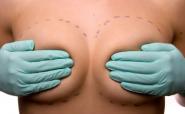Featured article
The key differences between saline and silicone explained

There are two basic types of implants that are used by plastic surgeons for breast enhancement – the saline implant (a silicone bag filled with a saltwater solution, “saline”), and the silicone implant (the same bag filled with silicone gel). Both types have been widely available since the US FDA lifted its moratorium on the silicone implants several years ago, after research showed that silicone in the body was not harmful.
Saline implants
Saline implants are simply a bag of water, and feel like a water balloon. They are provided to the surgeon by the manufacturer as sterile, empty bags in a variety of sizes. At the time of surgery the implant can be filled after being placed in the breast, or it can be filled first and then placed into the breast. Filling the implant during surgery creates some risk of contamination, although this risk is very minimal. On the other hand this allows for minor size adjustments at the time of surgery as needed.
Saline implants are almost always placed behind the pectoral (chest wall) muscle, so the implant casing cannot be felt once it is in place. Placing the implant behind the muscle is a little more invasive, adds time to the surgical procedure and makes the recovery a bit longer and more uncomfortable, but it produces a better feel for the patient and reduces the chance of having a rippling effect on the surface of breast skin following surgery.
Advertisement
If a leak develops, saline will seep out of the implant and be absorbed into the body. Saline is not harmful, but the implant will deflate within minutes. A deflated implant will need to be replaced, but the good news is that the major implant manufacturers will not only replace a deflated implant for no charge at any time, but they will also pay the cost for replacement for up to 10 years after surgery. Replacing an implant is much simpler and shorter than the original operation.
Silicone implants
Silicone implants of various sizes are provided to the surgeon pre-filled; the implant is removed from its sterile container and placed into the breast during surgery. The size of a silicone implant cannot be altered like a saline implant and therefore the patient, with the help of her doctor, must choose the size of the implant before surgery.
The feel and consistency of a silicone implant is very much like breast tissue. Unlike saline implants, silicone implants do not have to be placed behind the muscle and can be inserted just behind the breast tissue. The much heavier nature of silcon gel compared to saline means that even if not placed behind the muscle, silicone implants are unlikely to cause rippling of the breast surface after surgery.
Although the incidence of a silicone implant leaking is very low, if it does happen, the silicone will usually stay inside the silicone bag or at least inside the opening created for the implant, and will not deflate like a saline implant. In fact most patients would probably not realize that they have a leak unless they go in for a mammogram. The FDA recommends that a leaking implant be replaced, even though there is no evidence that it will harm a patient.
Silicone is more expensive than saline, but costs vary among regions and plastic surgeons.
How to choose
In simple terms; choose silicone if your priority is a more natural feel, choose saline if you would be worried about having silicone and you would prefer a more “natural” substance.
However such a choice should always be discussed with your surgeon; both types of implants come in different shapes as well as different sizes and can be either smooth surfaced or textured, and these details are very specific for each patient. Always consult a board certified plastic surgeon. In the US you can find a doctor in your area by consulting the website of the American Society of Plastic and Reconstructive Surgeons.
About the Author
Dr. Corwin has been practicing Plastic and Reconstructive Surgery in the Conejo Valley
since 1977 and specializes in cosmetic surgery
Theodore R.’s homepage: DoctorCorwin.com







